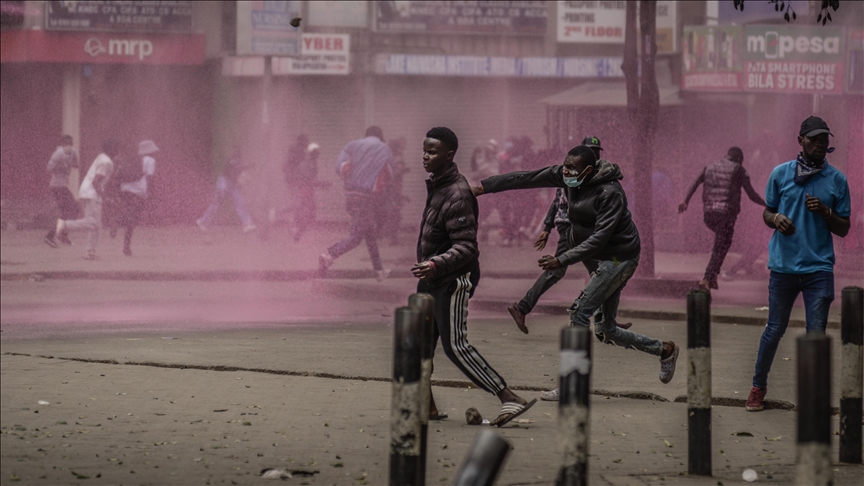Fears of more unrest as Kenya marks anniversary of 1990 protests
Mass demonstrations are expected on the anniversary of Kenya’s pro-democracy demonstrations of July 7, 1990, which challenged then-President Daniel Moi’s one-party rule
 Demonstration on the anniversary of protests against the “Finance Bill 2024” in Kenya
Demonstration on the anniversary of protests against the “Finance Bill 2024” in Kenya
- Kenyan government has dismissed claims of police brutality as exaggerated, saying steps taken by authorities were necessary for national security and preventing the spread of ‘incendiary content’
- Analysts warn that continued unrest could erode investor confidence and damage Kenya’s democratic standing, urging President Ruto to engage directly with protesters on demands for reforms
NAIROBI, Kenya
Political tensions in Kenya are escalating as citizens prepare for mass demonstrations on Monday, coinciding with the anniversary of the landmark Saba Saba protests of 1990.
Saba Saba, a Swahili term meaning “seven seven” in English, marks the anniversary of Kenya’s pro-democracy demonstrations of July 7, 1990, which challenged then-President Daniel Moi’s one-party rule.
Now, 35 years later, a new generation of Kenyans has taken up the mantle, protesting against economic inequality, misgovernance, and police violence.
The current unrest initially erupted online, sparked by outrage over tax increases proposed by President William Ruto’s administration. It has since transformed into a nationwide movement driven by Kenya’s digital-savvy Gen Z.
The movement intensified after the death of teacher and blogger Albert Omondi Ojwang in police custody on June 8. A pathologist’s report later refuted police claims that his injuries were self-inflicted, igniting national outrage. President Ruto has condemned the death and said he expects a “swift, transparent, and credible investigation.”
The June 17 police shooting of vendor Boniface Kariuki, who later died in hospital, further galvanized the public.
Nationwide demonstrations erupted on June 25 across at least 23 of Kenya’s 47 counties. According to human rights groups, at least 16 people were killed, with more than 400 injured, largely due to police actions.
Interior Minister Kipchumba Murkomen has dismissed reports of police brutality as exaggerated, stating that officers were working under extreme pressure to contain what he described as attempts to destabilize the country. Police officials have also accused some demonstrators of engaging in violence, vandalism, and looting.
Tight media controls, including broadcast restrictions, have sparked concerns over press freedom. The government has justified curbs on live media coverage as necessary to protect national security and prevent the spread of what it called “incendiary content.”
The Communications Authority of Kenya claimed the measures were temporary and aimed at curbing misinformation, but the move has drawn criticism from media houses and press freedom advocates.
‘We’re watching history repeat itself’
Observers say this year’s protests are a moment of reckoning, with protesters invoking the historical significance of July 7 to challenge the government.
“We’re watching history repeat itself,” said Wanjeri Nderu, a human rights activist and governance expert. “Young people have inherited this struggle, not by choice, but because they’re living its consequences.”
Civic-tech activist Nyamisa Chelagat highlighted the role of technology in the current movement.
“What we’re witnessing is a generation that isn’t afraid to confront the state, not with weapons, but with technology, numbers, and conviction,” she told Anadolu.
David Kyule, a history expert from the University of Nairobi, notes both similarities and differences from the Saba Saba protests: “In 1990, demands focused on political pluralism. Today, youth push for economic rights, digital freedoms, and a seat at the table shaping national policy. What’s constant is that both generations were dismissed by the state as chaotic or misinformed.”
Wider repercussions
The Kenyan government, through officials such as Murkomen, has defended police actions, arguing officers “are under pressure and act to restore order,” but is yet to offer any plans to reform use-of-force guidelines.
Opposition figures, however, demand accountability. Former Prime Minister Raila Odinga called on Ruto to “immediately dismiss the leadership in the police hierarchy,” while ex-Justice Minister Martha Karua pledged to introduce legislation in Parliament curbing excessive force.
Another lawmaker, Esther Passaris, has introduced a bill proposing significant changes to demonstration regulations. It seeks to ban protests within 100 meters of key government institutions, including Parliament, and impose fines of up to 100,000 Kenyan shillings (approximately $770) or imprisonment of up to three months for violators.
Mutula Kilonzo Jr, governor of Kenya’s eastern Makueni county, called the bill “retrogressive,” highlighting that Parliament, like democratic institutions elsewhere, should remain accessible for citizen engagement.
Joel Kamau Njoroge, a boda boda taxi rider in Nairobi, summed up public sentiment at the moment: “We’re tired of being ignored. Our voices only matter when we take to the streets; this is the only way we can get good governance.”
Now, as nationwide protests threaten to escalate, analysts warn that continued unrest could erode investor confidence and damage Kenya’s democratic standing, urging Ruto to engage directly with protesters on demands for reforms.
Anadolu Agency website contains only a portion of the news stories offered to subscribers in the AA News Broadcasting System (HAS), and in summarized form. Please contact us for subscription options.







